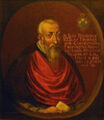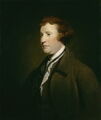Template:Selected anniversaries/November 1: Difference between revisions
No edit summary |
No edit summary |
||
| Line 56: | Line 56: | ||
||1963: The Arecibo Observatory in Arecibo, Puerto Rico, with the largest radio telescope ever constructed, officially opens. | ||1963: The Arecibo Observatory in Arecibo, Puerto Rico, with the largest radio telescope ever constructed, officially opens. | ||
||1967: Ludwig Roth dies . | File:Ludwig Roth - 1960.jpg|link=|1967: Aerospace engineer and weapons designer Ludwig Roth dies. During World War 2, Roth headed Germany's Future Projects Office which designed the ''Wasserfall'' and created advanced rocket designs such as the A9/A10 ICBM. Near the end of the war, Roth was recruited by American intelligence under Operation Paperclip. | ||
File:Nixon April-29-1974.jpg|link=Watergate scandal (nonfiction)|1973: [[Watergate scandal (nonfiction)|Watergate scandal]]: Leon Jaworski is appointed as the new Watergate Special Prosecutor. | File:Nixon April-29-1974.jpg|link=Watergate scandal (nonfiction)|1973: [[Watergate scandal (nonfiction)|Watergate scandal]]: Leon Jaworski is appointed as the new Watergate Special Prosecutor. | ||
| Line 68: | Line 68: | ||
||1996: Maxwell or Max Erich (Eric) Reissner dies ... civil engineer and mathematician. He is remembered by the New York Times (1996) as the "mathematician whose work in applied mechanics helped broaden the theoretical understanding of how solid objects react under stress and led to advances in both civil and aerospace engineering." Pic. | ||1996: Maxwell or Max Erich (Eric) Reissner dies ... civil engineer and mathematician. He is remembered by the New York Times (1996) as the "mathematician whose work in applied mechanics helped broaden the theoretical understanding of how solid objects react under stress and led to advances in both civil and aerospace engineering." Pic. | ||
File:Theodore Hall ID badge.png|link=Theodore Hall (nonfiction)|1999: American physicist and Soviet spy [[Theodore Hall (nonfiction)|Theodore Hall]] dies. During his work on US efforts to develop the first and second atomic bombs during World War II (the Manhattan Project), Hall gave a detailed description of the "Fat Man" plutonium bomb, | File:Theodore Hall ID badge.png|link=Theodore Hall (nonfiction)|1999: American physicist and Soviet spy [[Theodore Hall (nonfiction)|Theodore Hall]] dies. During his work on US efforts to develop the first and second atomic bombs during World War II (the Manhattan Project), Hall gave Soviet intelligence a detailed description of the "Fat Man" plutonium bomb, along with several processes for purifying plutonium. | ||
||2006: Leon Albert Henkin dies ... logician at the University of California, Berkeley. He was principally known for "Henkin construction", his version of the proof of the semantic completeness of standard systems of first-order logic. Pic. | ||2006: Leon Albert Henkin dies ... logician at the University of California, Berkeley. He was principally known for "Henkin construction", his version of the proof of the semantic completeness of standard systems of first-order logic. Pic. | ||
Revision as of 19:31, 1 November 2019
1585: Mathematician, physician, and astronomer Jan Brożek born. Brożek will contribute to a greater knowledge of Nicolaus Copernicus' theories, and be Copernicus' ardent supporter and early prospective biographer.
1790: Edmund Burke publishes Reflections on the Revolution in France, in which he predicts that the French Revolution will end in a disaster.
1932: Broadway production based on famed illustration Alice and Niles Dancing is a smash hit.

1967: Aerospace engineer and weapons designer Ludwig Roth dies. During World War 2, Roth headed Germany's Future Projects Office which designed the Wasserfall and created advanced rocket designs such as the A9/A10 ICBM. Near the end of the war, Roth was recruited by American intelligence under Operation Paperclip.
1973: Watergate scandal: Leon Jaworski is appointed as the new Watergate Special Prosecutor.
1993: Biochemist and academic Severo Ochoa dies. In 1959, Ochoa and Arthur Kornberg were awarded the Nobel Prize for Physiology or Medicine "for their discovery of the mechanisms in the biological synthesis of ribonucleic acid and deoxyribonucleic acid".
1999: American physicist and Soviet spy Theodore Hall dies. During his work on US efforts to develop the first and second atomic bombs during World War II (the Manhattan Project), Hall gave Soviet intelligence a detailed description of the "Fat Man" plutonium bomb, along with several processes for purifying plutonium.





